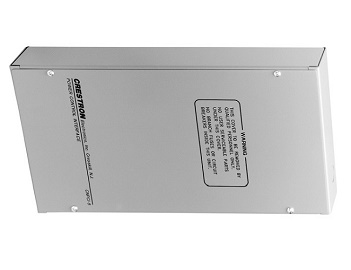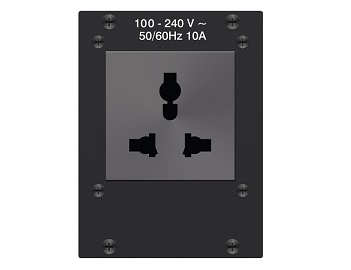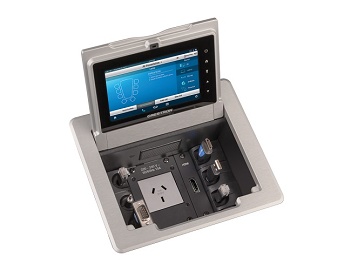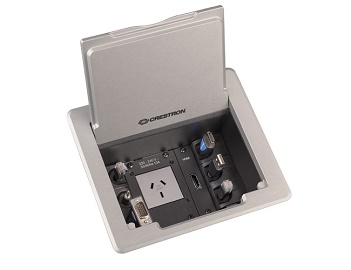技術(shù)規(guī)格
Operating System
Crestron® 2-Series; real-time, preemptive, multi-threaded/multitasking kernel; FAT32 file system with long names
Memory
SDRAM 32 MB
NVRAM 256 KB
Flash 16 MB
Communications
Ethernet 10/100/1000 Mpbs; auto-switching; auto-negotiating; auto-discovery; full/half duplex; TCP/IP; UDP/IP; CIP; DHCP; Private Network Mode; SSL; SNMP; IPv4; RSTP; SMTP e-mail client; Web Server; installer setup via Crestron Toolbox™
Cresnet Cresnet® master mode
DigitalMedia DM 8G+™, HDCP, EDID, CEC, PoDM, HDBaseT® compliant
HDMI HDMI®, HDCP, EDID, CEC
USB USB service port for computer console, USB HID signal routing over DM
RS-232 2-way device control and monitoring up to 115.2k baud with hardware and software handshaking
IR/Serial 1-way device control via infrared up to 1.2 MHz or serial TTL/RS-232 (0-5 Volts) up to 115.2k baud; supports CNXRMIRD IR Receiver[4]
Ethernet Switch
8-port switch with Private Network Mode; provides (1) rear panel 10/100/1000Base-T Gigabit Ethernet port and (7) internal 10Base-T/100Base-TX Ethernet ports for the control processor, switcher, audio DSP, and DM ports
Video
Switcher Auto-detecting multi-format digital/analog source inputs, 7x4 matrix switcher, HDMI and DM 8G+ outputs, QuickSwitch HD® technology
Input Signal Types HDMI (Inputs 1-5), RGB[5] (Inputs 3-5), composite/S-Video/component (Input 5), DM 8G+ and HDBaseT (Inputs 6 & 7)
Output Signal Types HDMI (Outputs 1 & 2), DM 8G+ and HDBaseT (Outputs 3 & 4)
Formats HDMI w/Deep Color & 3D[6], DVI[1], DisplayPort Multimode[1], HDCP content protection support, HD up to 1080i/1080p, computer up to UXGA/WUXGA, RGBHV, RGBS, RGSB, YPbPr, Y/C, NTSC, PAL
Input Resolutions, HDMI & HDBaseT, Progressive 640x480@60Hz, 720x480@60Hz (480p), 720x576@50Hz (576p), 800x600@60Hz, 848x480@60Hz, 852x480@60Hz, 854x480@60Hz, 1024x768@60Hz, 1024x852@60Hz, 1024x1024@60Hz, 1280x720@50Hz (720p50), 1280x720@60Hz (720p60), 1280x768@60Hz, 1280x800@60Hz, 1280x960@60Hz, 1280x1024@60Hz, 1360x768@60Hz, 1365x1024@60Hz, 1366x768@60Hz, 1400x1050@60Hz, 1440x900@60Hz, 1600x900@60Hz, 1600x1200@60Hz, 1680x1050@60Hz, 1920x1080@24Hz (1080p24), 1920x1080@25Hz (1080p25), 1920x1080@50Hz (1080p50), 1920x1080@60Hz (1080p60), 1920x1200@60Hz, 2048x1080@24Hz, 2048x1152@60Hz, plus any other resolution allowed by HDMI up to 165MHz pixel clock
Input Resolutions, HDMI & HDBaseT, Interlaced 720x480@30Hz (480i), 720x576@25Hz (576i), 1920x1080@25Hz (1080i25), 1920x1080@30Hz (1080i30), plus any other resolution allowed by HDMI up to 165MHz pixel clock
Input Resolutions, RGB 640x480@60Hz, 720x480@60Hz (480p), 720x576@50Hz (576p), 800x600@60Hz, 848x480@60Hz, 1024x768@60Hz, 1280x720@50Hz (720p50), 1280x720@60Hz (720p60), 1280x768@60Hz, 1280x800@60Hz, 1280x960@60Hz, 1280x1024@60Hz, 1360x768@60Hz, 1366x768@60Hz, 1400x1050@60Hz, 1440x900@60Hz, 1600x1200@60Hz, 1680x1050@60Hz, 1920x1080@50Hz (1080p50), 1920x1080@60Hz (1080p60), 1920x1200@60Hz, 2048x1152@60Hz
Input Resolutions, Component 480i, 576i, 480p, 576p, 720p50, 720p60, 1080p24, 1080i25 (1125 lines), 1080i30, 1080p30, 1080p50 (1125 lines), 1080p60
Input Resolutions, Composite and S-Video 480i, 576i
Output Resolutions Matched to inputs
Analog-To-Digital Conversion 10-bit 165 MHz per each of 3 channels
RGB Source Image Adjustments Brightness: 0% to 50%;
Contrast: -50% to +50%;
Fine Phase: -16 to *15;
X Position: -100 to +100;
Y Position: -10 to +10;
RGB Gains: -50 to +50, separately adjustable for Red, Green, and Blue
YPbPr, Y/C, or Composite Source Image Adjustments Brightness: 0% to 50%;
Contrast: -50% to +50%;
Saturation: -50% to +50%;
Hue: -50% to +50%
Audio
Switcher/Mixer 6-channel gated mic mixer w/DSP, auto-detecting multi-format digital/analog source inputs, DigitalMedia 8G+ inputs (HDBaseT compatible), 7x7 stereo source switcher, 7x4 multi-channel source switcher, analog and HDMI outputs, DM 8G+ outputs (HDBaseT compatible), independent 6-ch mic + source mixer per output, independent stereo DSP per analog output, integrated power amplifier, digital audio pass-through mode
Typical of 6 microphone input channels:
Input Signal Types Mono analog mic or line level
Analog-To-Digital Conversion 24-bit 48 kHz
Phantom Power Enable/Disable per channel
Gain 0 to +60 dB Gain adjustment, plus Mute
Delay 0.0 to 85.3 ms
EQ Center Frequencies 160, 500, 1.2k, 3k Hz
EQ Gain ±12.0 dB per band
Gating Level (Threshold) -80 to 0 dB
Gating Depth (Attenuation) -80 to 0 dB
Gating Attack 1 to 250 ms
Gating Decay (Release) 1 to 1000 ms
Compression Level (Threshold) -80 to 0 dB
Compression Ratio 1:1 to 10:1
Compression Attack 1 to 250 ms
Compression Release 1 to 1000 ms
Compression Curve Hard or soft knee
Limiting Level (Threshold) -80 to 0 dB
Limiting Attack 1 to 250 ms
Limiting Release 1 to 1000 ms
Limiting Curve Hard or soft knee
Typical of 7 source input channels:
Input Signal Types HDMI or DisplayPort Multimode[1] (Inputs 1-5), analog 2-channel (Inputs 1-5), S/PDIF (Input 5), DM 8G+/HDBaseT (Inputs 6 & 7)
Formats, Analog Stereo 2-Channel
Formats, HDMI & DM Dolby Digital®, Dolby Digital EX, DTS®, DTS-ES, DTS 96/24, up to 8ch PCM
Formats, SPDIF 2ch PCM
Analog-To-Digital Conversion 24-bit 48 kHz
Input Compensation ±10.0 dB
Typical of 3 analog line outputs w/DSP:
Output Signal Type/Format Stereo 2-Channel
Digital-To-Analog Conversion 24-bit 48 kHz
Mic 1 – 6 -80 to +10 dB Level adjustment range, plus Mute and Pan
Mics Master -80 to +10 dB Level adjustment range, plus Mute
Left/Right (Source) -80 to +10 dB Level adjustment range, separately adjustable for Left and Right, plus Mute
Master Volume -80 to +10 dB Level adjustment range, plus Mute
Mixer Presets 1 thru 5
Bass ±12.0 dB
Treble ±12.0 dB
Equalization 10-band graphic + 2-band parametric
GEQ Center Frequencies 31.5, 63, 125, 250, 500, 1k, 2k, 4k, 8k, 16k Hz
GEQ Gain ±12.0 dB per band
GEQ Presets 1 thru 10
PEQ Center Frequencies 5 to 24000 Hz per band
PEQ Gain -36.0 to +24.0 dB per band
PEQ Bandwidth 0.02 to 3.50 octaves per band
PEQ Types Peaking EQ, High Pass, Low Pass, High Shelf, Low Shelf, Notch
PEQ Presets 1 thru 5
Delay 0.0 to 85.3 ms
Frequency Response 20Hz to 20kHz ±0.5 dB (digital source);
20Hz to 20kHz ±0.5 dB (analog line source);
20Hz to 20kHz ±0.7 dB (microphone source)
S/N Ratio >108 dB (digital source), 1 kHz, A-weighted;
>103 dB (analog line source), 1 kHz, A-weighted
THD+N <0.002% (digital source), 20 Hz to 20 kHz;
<0.005% (analog line source), 20 Hz to 20 kHz;
<0.05% (microphone source), 20 Hz to 20 kHz
Stereo Separation >108 dB (digital source);
>103 dB (analog source)
Channel Separation >103 dB
Typical of 4 HDMI & DM outputs:
Output Signal Types HDMI (Outputs 1 & 2), DM 8G+ and HDBaseT (Outputs 3 & 4)
Formats Dolby Digital, Dolby Digital EX, DTS, DTS-ES, DTS 96/24, up to 8ch PCM
Mic 1 – 6 -80 to +10 dB Level adjustment range, plus Mute and Pan[7]
Mics Master -80 to +10 dB Level adjustment range, plus Mute[7]
Left/Right (Source) -80 to +10 dB Level adjustment range, separately adjustable for Left and Right, plus Mute[7]
Master Volume -80 to +10 dB Level adjustment range, plus Mute[7]
Mixer Presets 1 thru 5
Frequency Response 20Hz to 20kHz ±0.5 dB (digital source);
20Hz to 20kHz ±0.5 dB (analog line source);
20Hz to 20kHz ±0.7 dB (microphone source)
S/N Ratio >108 dB (digital source), 1kHz, A-weighted;
>103 dB (analog line source), 1kHz, A-weighted
THD+N <0.002% (digital source), 20 Hz to 20 kHz;
<0.005% (analog line source), 20 Hz to 20 kHz;
<0.05% (microphone source), 20 Hz to 20 kHz
Stereo Separation >108 dB (digital source);
>103 dB (analog source)
Channel Separation >108 dB (digital source);
>103 dB (analog source)
Stereo Amplified Output (same signal as Program output):
Output Power, 4/8 ? 20 Watts RMS per channel at 8 Ohms, 4 Ohms tolerant
Output Power, 70/100V 40 Watts RMS
Frequency Response 20 Hz to 20 kHz ±1 dB @ 20 Watts into 8 Ohms;
100 Hz to 20 kHz ±2.5 dB @ 70 or 100 Volts
S/N Ratio 98 dB @ 20 Watts into 8 Ohms, 1 kHz, A-weighted;
96 dB @ 20 Watts in 4 Ohms, 1 kHz, A-weighted
THD+N <0.1% (1 kHz), <0.7% (20 Hz to 20 kHz), @ 20 Watts into 4 or 8 Ohms
Stereo Separation >65 dB @ 20 Watts, 1 kHz
Connectors – Audio/Video Inputs
HDMI INPUT 1 – 5 (5) 19-pin Type A HDMI female, digital video/audio inputs;
Signal Types: HDMI, DVI, or DisplayPort Multimode[1,6]
RGB INPUT 3 – 5 (3) DB15HD female, analog RGB/video inputs;
Signal Types: RGBHV, component, S-Video, or composite[5];
Formats: RGBHV, RGBS, RGsB, YPbPr, Y/C, NTSC or PAL;
Input Level: 0.5 to 1.5 Vp-p with built-in DC restoration;
Input Impedance: 75 Ohms nominal;
Sync Detection: RGBHV, RGBS, RGsB, YPbPr;
Sync Input Level: 3 to 5 Vp-p;
Sync Input Impedance: 2.2k Ohms;
Note: RGB Inputs 3-5 and HDMI Inputs 3-5 are mutually exclusive; HDMI overrides RGB when using the auto-switching feature
Y, PB/Y, PR/C/COMP INPUT 5 (3) BNC female comprising (1) auto-sensing multi-format analog video input;
Signal Types: Component, S-Video, or composite;
Formats: YPbPr, Y/C, NTSC or PAL;
Input Level: 1 Vp-p nominal;
Input Impedance: 75 Ohms nominal;
Note: Video Input 5, RGB Input 5, and HDMI Input 5 are mutually exclusive; HDMI and RGB override Video when using the auto-switching feature
SPDIF INPUT 5 (1) RCA female, S/PDIF coaxial digital audio input;
Input Impedance: 75 Ohms;
Note: SPDIF Input 5 and HDMI Input 5 are mutually exclusive; HDMI overrides SPDIF when using the auto-switching feature
AUD IN 1 – 5 (5) 5-pin 3.5mm detachable terminal blocks;
Balanced/unbalanced stereo line-level analog audio inputs;
Input Impedance: 24k Ohms balanced/unbalanced;
Maximum Input Level: 4 Vrms balanced, 2 Vrms unbalanced;
Note: Analog Audio Inputs 1-5, SPDIF Input 5, and HDMI Inputs 1-5 are mutually exclusive; HDMI and SPDIF override Analog Audio when using the auto-switching feature
DM INPUT 6 – 7 (2) 8-pin RJ45 female, shielded;
DM 8G+ inputs, HDBaseT compliant;
PoDM and PoH PSE (Power Sourcing Equipment) ports[3];
Connect to DM 8G+ outputs of DM transmitters or other DM devices, or to HDBaseT devices, via CAT5e or Crestron DM-CBL-8G cable[2]
MC1/LN1 – MC6/LN6 (6) 5-pin 3.5mm detachable terminal blocks;
Comprises (6) balanced microphone/line audio inputs;
Balanced Mic Input Level: -60 to 0 dBV, 1 Vrms maximum;
Balanced Line Input Level: -31 to +11 dBV, 3.7 Vrms maximum;
Unbalanced Line Input Level: -37 to +5 dBV, 1.85 Vrms maximum;
Mic Input Impedance: 3.9k Ohms balanced;
Line Input Impedance: 19k Ohms balanced, 9.5k Ohms unbalanced;
Phantom Power: 48 Volts DC, software enabled/disabled per channel
Connectors – Audio/Video Outputs
SPEAKER OUTPUT
4?/8? L – R (2) 2-pin 7.62mm 15A detachable terminal blocks;
4-8 Ohm stereo speaker-level audio output;
Wire Size: Terminals accept up to 14 AWG;
Output Power: 20W RMS per channel stereo at 8 Ohms, 4 Ohms tolerant
SPEAKER OUTPUT 70/100V (1) 2-pin 7.62mm 15A detachable terminal block;
Transformer-isolated 70 or 100 Volt mono speaker-level audio output;
Wire Size: Terminals accept up to 14 AWG;
Output Power: 40W RMS mono at 70 or 100 Volts;
Note: 4?/8? and 70/100V outputs are mutually exclusive
PROG OUT (1) 5-pin 3.5mm detachable terminal block;
Balanced/unbalanced stereo line-level audio output;
Output Impedance: 200 Ohms balanced, 100 Ohms unbalanced;
Maximum Output Level: 4 Vrms balanced, 2 Vrms unbalanced
AUX OUT 1 – 2 (2) 5-pin 3.5mm detachable terminal blocks;
Balanced/unbalanced stereo line-level audio outputs;
Output Impedance: 200 Ohms balanced, 100 Ohms unbalanced;
Maximum Output Level: 4 Vrms balanced, 2 Vrms unbalanced
HDMI OUTPUT 1 – 2 (2) 19-pin Type A HDMI female, digital video/audio outputs;
Signal Types: HDMI, DVI[1]
DM OUTPUT 3 – 4 (2) 8-pin RJ45 female, shielded;
DM 8G+ outputs, HDBaseT compliant;
PoDM and PoH PSE (Power Sourcing Equipment) ports[3];
Connect to DM 8G+ inputs of DM receivers/room controllers or other DM devices, or to HDBaseT devices, via CAT5e or Crestron DM-CBL-8G cable[2]
Connectors - Control & Power
IR/SERIAL OUT 1 – 4 (4) 2-pin 3.5mm detachable terminal blocks;
IR/Serial output ports;
IR output up to 1.2 MHz;
1-way serial TTL/RS-232 (0-5 Volts) up to 115.2k baud
IR IN (1) 3-pin 3.5mm detachable terminal block
For connection of the CNXRMIRD IR Receiver[4];
Allows control from IR wireless remotes using RC-5 command set
INPUT 1 – 4 (1) 5-pin 3.5mm detachable terminal block;
Comprises (4) programmable digital inputs;
Input Voltage Range: 0 to 24 Volts DC, referenced to GND;
Logic Threshold: 2.5 Volts DC nominal with 1 Volt hysteresis band;
Input Impedance: 10k Ohms at >5 Volts, 1M Ohms at <5 Volts;
Pull-up Resistor: 2.2k Ohms per input
RELAY 1 – 4 (1) 8-pin 3.5mm detachable terminal block;
Comprises (4) normally open, isolated relays;
Rated 1 Amp, 30 Volts AC/DC;
MOV arc suppression across contacts
COM A – B (2) DB9 male, bidirectional RS-232 ports;
Up to 115.2k baud, hardware and software handshaking support
NET (4) 4-pin 3.5mm detachable terminal blocks;
Cresnet Master ports, paralleled;
Available Cresnet Power: 30 Watts
SERVICE (1) USB Type B female, for factory use only
PoDM 48VDC IN (1) 4-pin snap & lock power jack;
48 Volt DC power input for PoDM power pack[3];
Enables PoDM and PoH power sourcing
100-240V~4.0A 50/60Hz (1) IEC 60320 C14 main power inlet;
Mates with removable power cord, included
G (1) 6-32 screw, chassis ground lug
LAN (1) 8-wire RJ45 female,10Base-T/100Base-TX/1000Base-T Ethernet port
COMPUTER (front) (1) USB Type B female;
USB computer console port (cable included)
LCD Display
Green LCD alphanumeric, adjustable backlight,2 lines x 20 characters per line;
Displays input/outputs by name, volume levels, setup menus, signal routing, device info, and other system information
Controls & Indicators
NET (1) yellow LED, indicates Cresnet bus activity
LAN (1) yellow LED, indicates Ethernet activity
HW-R (1) recessed miniature pushbutton for hardware reset, reboots the control system
SW-R (1) recessed miniature pushbutton for software reset, restarts the SIMPL program
POWER (1) pushbutton and green LED, programmable for system power control
SOFTKEYS (4) pushbuttons for activation of LCD driven functions and passcode entry
MENU (1) pushbutton, steps menu back one level
Λ, V (2) pushbuttons, scroll up or down through menu and adjust menu parameters
ENTER (1) pushbutton, executes highlighted menu or value
VOLUME (1) continuous turn rotary encoder, adjusts menu parameters, defaults to Program audio volume
MUTE (1) pushbutton and red LED, mutes the Program audio output
ROUTE (1) pushbutton and red LED, selects ROUTE mode to allow routing changes
VIEW (1) pushbutton and red LED, selects VIEW mode to view current routing
INFO (1) pushbutton and red LED, selects INFO mode to view AV and device info
INPUTS 1 – 7 (7) pushbuttons and red LEDs, select input to be routed
OUTPUTS 1 – 4, PROG, AUX 1 – 2 (7) pushbuttons and red LEDs, select output destination(s)
SPEAKER OUTPUTS (1) 3-position slide switch, selects the amplifier output configuration
DM INPUT 6 – 7 (rear) (4) LEDs, green LEDs indicate DM link status, amber LEDs indicate video and HDCP signal presence, for each respective port
DM INPUT 6 – 7 PoDM (rear) (2) green LEDs, indicate upstream device is drawing power over DM for each respective port
DM OUTPUT 3 – 4 (rear) (4) LEDs, green LEDs indicate DM link status, amber LEDs indicate video and HDCP signal presence, for each respective port
DM OUTPUT 3 – 4 PoDM (rear) (2) green LEDs, indicate downstream device is drawing power over DM for each respective port
LAN (rear) (2) LEDs, bi-color LED (left) indicates Ethernet speed and activity, green LED (right) indicates Ethernet link status
Power Requirements
Main Power 4 Amps @ 100-240 Volts AC, 50/60 Hz
Available Cresnet Power 30 Watts
Power over DM (PoDM) PoDM PSE (Power Sourcing Equipment), supplies power to PoDM Powered Devices[3]
Power over HDBaseT (PoH) PoH PSE (Power Sourcing Equipment), supplies power to PoH Powered Devices[3]
PoDM Power Pack 1.875 Amp @ 48 Volts (100-240 Volts AC, 50/60 Hz power pack, model PW-4818DU sold separately)
Environmental
Temperature 41° to 104°F (5° to 40°C)
Humidity 10% to 90% RH (non-condensing)
Heat Dissipation 277 BTU/hr
Enclosure
Chassis Metal, black finish, fan-cooled, vented sides
Front Panel Metal, black finish with polycarbonate label overlay
Mounting Freestanding or 3U 19-inch rack-mountable (adhesive feet and rack ears included)
Dimensions
Height 5.20 in (133 mm) without feet
Width 17.28 in (439 mm);
19.00 in (483 mm) with rack ears
Depth 16.31 in (415 mm)
Weight
22 lb (9.9 kg)






